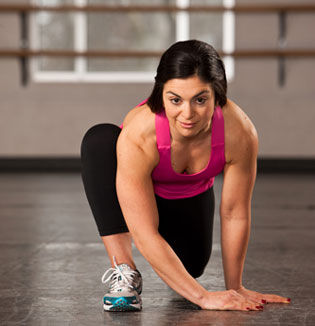
You’ve likely worked with clients or group fitness participants who have experienced some issues with their hamstrings. At best, sore hamstrings can cause discomfort and significantly limit an individual’s ability to participate in an exercise program. At worst, a client can place too much force into the muscle, causing a severe strain or tear. Having a better understanding of how the hamstrings function enhances your ability to help others improve the function of these muscles, which can, in turn, relieve soreness while also improving both strength and appearance.
Despite their critical role in movement and injury prevention, the hamstrings are often misunderstood—particularly in how they function during both phases of muscle action. As a result, while many health and exercise professionals consider the concentric function of the hamstrings, it is necessary to consider both the concentric and eccentric functions of this muscle group.
When it comes to describing human anatomy, the focus often tends to be on what a muscle does during the shortening or concentric phase of muscle action. However, it is important to remember that muscles play an important role during the eccentric phase of muscle action, when they are being lengthened in reaction to an applied force. Understanding how a muscle functions as it is being lengthened is important for two specific reasons:
As a muscle moves through the eccentric phase of a movement, it is storing potential energy, which is then released once the muscle transitions to the concentric phase.

Greater mechanical forces are at work during the eccentric phase of muscle action and many soft-tissue injuries can be caused by the inability of muscle tissue to allow a rapid change of length. If a muscle has the proper extensibility to lengthen in response to an applied force, it can efficiently convert the mechanical energy stored during the eccentric phase to kinetic energy as the muscle shortens to generate a force.
To fully appreciate the functional role of the hamstrings during movement—particularly their contribution during the eccentric phase—it’s important to understand their anatomical structure and how each muscle in the group contributes to joint motion and stability. Examining the specific origin, insertion and integrated actions of each hamstring muscle will give you a clearer picture of how this group supports efficient locomotion and how targeted exercises can help reduce the risk of injury.
The Hamstring Complex

The hamstrings muscle group includes three specific muscles that start at the bottom of the pelvis, run along the back and sides of the femur, and attach to the top of the tibia and fibula bones of the lower leg (Table 1). The three muscles of the hamstrings are: semitendinosus, semimembranosus and the biceps femoris. (Note: The short head of the biceps femoris starts on the posterior side of the femur and connects with the rest of the muscle as it moves toward the insertion point on the head of the fibula. For the purposes of this article, however, we’ll focus on the function of the long head, which controls motion at both the hip and knee joints).

The most common exercises for the hamstrings focus on how they function in an open chain (where the feet are not in contact with the ground) to create knee flexion. While these movements can help the appearance of the muscles, they do not prepare the hamstrings to perform more efficiently during upright dynamic movements such as walking, running or jumping. Instead of flexing the knee when walking or running, the hamstrings work eccentrically to decelerate knee extension, create stability and actually function as a knee extensor.
Table 1. Attachments and Actions of the Hamstring Muscles
|
|
Muscle
|
Superior Attachment
|
Inferior Attachments
|
Integrated Function
|
|
Semitendinosus
|
The biceps femoris and semitendinosus share a common origin at the upper, outer quadrant of the posterior surface of the ischial tuberosity, inferior to the semimembranosus
|
Combines with the sartorius and gracilis muscles to form the pes anserinus tendon that attaches to the superior medial tibia
|
Decelerates hip flexion and knee extension prior to ground contact; decelerates external rotation of knee; controls stability of knee
|
|
Biceps femoris
|
The superior head of the fibula and lateral condyle of the tibia
|
Decelerates hip flexion and knee extension prior to ground contact; decelerates internal rotation of the knee; controls functional stability of the knee
|
|
Semimembranosus
|
Ischial tuberosity, superior and lateral to the biceps femoris and semitendinosus
|
Superior medial head of the tibia (attaching to the connective tissue in the posterior-medial capsule of the knee)
|
Decelerates hip flexion and extension of the knee prior to ground contact; decelerates external rotation of the knee; controls functional stability of the knee
|
Understanding Movement of the Hamstrings
Tightness in the Hamstrings
Tightness of the hip flexor muscles that connect the intervertebral segments of the lumbar spine to the pelvis and lesser trochanters of the femur bones can create an anterior tilt of the pelvis. If the muscles in front of the pelvis are tight, it can elevate the ischial tuberosities, which are the superior attachments of the hamstrings. If this happens, the hamstrings are placed in a lengthened position, which can create the sensation of tightness. Rather than trying to stretch tight hamstrings, however, stretch the muscles of the anterior hip—the flexors—to minimize the anterior tilt and allow the inferior segments of the pelvis to move back to a normal resting position.

Start with the kneeling hip flexor stretch, hold the position for 30 to 45 seconds and repeat twice on each leg. Progress to the lunge with elbow instep and focus on extending the back leg to maximize the stretch in the hip flexors and relieve tightness in the hamstrings. Hold each stretch for approximately five to 10 seconds, alternate sides and complete four to six repetitions on each leg.

In the human body, skeletal structures and muscles are aligned in such a way to make the gait cycle of walking and running as mechanically efficient as possible. To develop the best understanding of how a muscle works, it is important to understand how it produces and controls movement during the gait cycle. When walking or running, the body experiences two constant, competing forces: (1) gravity, which accelerates the body into the ground, is a top-down force; and (2) ground reaction forces, which are generated from the impact of the foot on the ground and transmitted into the body from the bottom up. These two forces influence movement of the body from each direction: top-down and bottom-up. Because the hamstrings connect the pelvis to the thigh and the thigh to the lower leg, these muscles must be able to lengthen in all three planes of motion to store mechanical energy, which is then used to generate the force to continue moving the body over the ground. If exercises focus exclusively on the concentric function of the hamstrings, these muscles may lose the necessary extensibility to be able to lengthen in response to applied forces. This, in turn, could be a possible mechanism of injury.
During the gait cycle, the hamstrings are lengthened at the proximal attachment as the hip is flexing forward during the leg swing, while simultaneously being lengthened at the distal attachment as the knee extends prior to ground contact. Even though they are often classified as a knee flexor, the hamstrings are most active as the knee reaches full extension, which is immediately before the foot touches the ground at the heel strike phase of the gait cycle. During the leg swing phase of the gait cycle, the hip is flexing and the knee is extending, which lengthens all three hamstring muscles at both the proximal and distal attachments. This creates a maximal eccentric load in the hamstrings prior to ground contact, which is the primary function of the hamstring muscles—storing elastic energy during the leg swing phase to then help create propulsion once the foot is on the ground during the gait cycle.
When the foot is fixed on the ground, as it is during the mid-stance phase of the gait cycle, the hamstrings function to help extend the femur, while creating stability in the knee and controlling motion of the lower leg. As the body transitions over a fixed foot, all three hamstring muscles shorten at the distal attachments to create a posterior slide of the tibial plateau (the superior portion of the tibia) under the condyles of the femur. In plain language, this means that instead of flexing the knee, the hamstrings play a role in knee extension when the foot is on the ground and the body is moving over it when transitioning from one leg to the next.
Exercises to Strengthen the Hamstrings
Because the hamstrings experience the greatest amount of force when decelerating knee extension and hip flexion prior to ground contact during gait, it is important to use exercises that involve both the hip and knee joints simultaneously. Effective strategies for strengthening the hamstrings focus on keeping the feet in a closed kinetic chain, while creating both knee and hip extension. (Note: If the feet are in contact with an object such as a stability ball or held in place in a glute and hamstring bench, the body will act as if it’s in a closed chain and involve both the proximal and distal attachments of the hamstring muscles.)
|
|
Exercise
|
Description
|
|
Standing Hip Extensions
|
Wrap a mini-band around both ankles. Balance on the left leg with the left knee slightly bent and the foot pressed firmly into the floor. Keep the right foot facing forward while pushing back through the heel. To emphasize eccentric strength, allow the leg to slowly return to the starting position. Do 12 to 15 repetitions with the right leg before switching to the left leg. Rest 30 seconds and repeat for a total of two to three sets on each leg.
|
|
Supine Hamstring Curls on a Stability Ball
|
This exercise uses both the superior attachments by the pelvis as well as the distal attachments at the lower leg. Lie on your back and place both heels on the top of a well-inflated stability ball. Press your heels in to the top of the ball while lifting your hips. Hold your hips off the floor as you pull your heels toward your tailbone. Slowly extend your legs and lower your hips to the floor. Perform 10 to 12 repetitions, rest for 60 seconds and repeat for a total of two to three sets. TIP: Keep your toes dorsiflexed and heels pushed away from you as you do this movement to reduce tightness in the calf muscles.
|
|
Anterior Step-up
|
Stand behind a jump box or step that is approximately knee height. Hold a dumbbell in each hand and place the right foot on top of the step. Keep your spine tall and press your right foot into the step to press yourself up to the top. Pause without setting the left foot down before slowly lowering yourself back down. Bring your right foot back to the floor and place it next to your left. Complete eight to 10 repetitions on the right leg before switching legs. Complete two to three sets, resting for 30 to 45 seconds between each set.
|
|
Romanian Deadlift (RDL)
|
Hold a barbell with both hands so that it is resting along the front of your thighs. Keep a slight bend in both knees while maintaining length through your spine as you push your hips back (allowing your hips to flex) and lower the weight toward the floor. (TIP: DO NOT round your back or keep your knees extended as you do this movement.) Continue lowering until you feel tension in the back of your thighs. To return to standing, push your heels into the floor and press your hips forward while keeping a long spine. (TIP: Think about pulling your knees backwards as you return to standing). Complete two to three sets of 10 to 12 repetitions each, resting for 60 seconds between each set.
|
Summary
The hamstrings, like all muscles, are influenced by motion created by the competing forces of gravity, ground reaction and momentum. Focusing on only the concentric function of a muscle significantly limits its ability to handle the forces it will experience during eccentric lengthening. Now that you know how the muscles work eccentrically to decelerate hip flexion and knee extension during leg swing, and that they actually create knee extension when the foot is planted on the ground, you are better able to help clients and class participants experience the greatest benefits from exercise, while also limiting their risk of developing hamstring strains.





 by
by 







